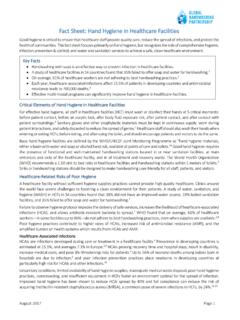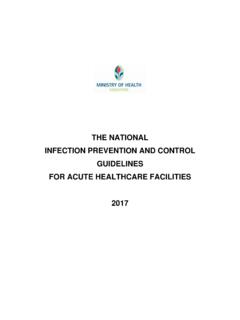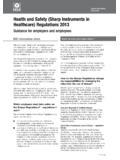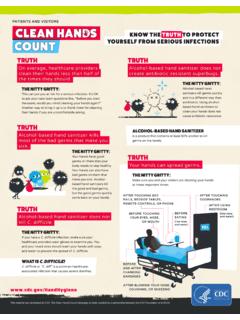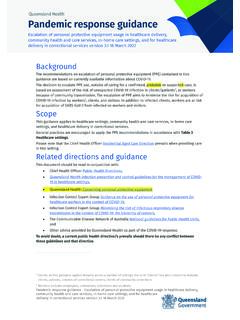Transcription of Getting your workplace ready for COVID-19
1 1 3 March 2020 Getting your workplace ready for COVID-19 In January 2020 the World Health Organization (WHO) declared the outbreak of a new coronavirus disease in Hubei Province, China to be a Public Health Emergency of International Concern. WHO stated there is a high risk of the 2019 coronavirus disease ( COVID-19 ) spreading to other countries around the world. WHO and public health authorities around the world are taking action to contain the COVID-19 outbreak. However, long term success cannot be taken for granted. All sections of our society including businesses and employers must play a role if we are to stop the spread of this disease. How COVID-19 spreads When someone who has COVID-19 coughs or exhales they release droplets of infected fluid.
2 Most of these droplets fall on nearby surfaces and objects - such as desks, tables or telephones. People could catch COVID-19 by touching contaminated surfaces or objects and then touching their eyes, nose or mouth. If they are standing within one meter of a person with COVID-19 they can catch it by breathing in droplets coughed out or exhaled by them. In other words, COVID-19 spreads in a similar way to flu. Most persons infected with COVID-19 experience mild symptoms and recover. However, some go on to experience more serious illness and may require hospital care. Risk of serious illness rises with age: people over 40 seem to be more vulnerable than those under 40.
3 People with weakened immune systems and people with conditions such as diabetes, heart and lung disease are also more vulnerable to serious illness. This document gives advice on: 1. Simple ways to prevent the spread of COVID-19 in your workplace 2. How to manage COVID-19 risks when organizing meetings & events 3. Things to consider when you and your employees travel 4. Getting your workplace ready in case COVID-19 arrives in your community 1. Simple ways to prevent the spread of COVID-19 in your workplace The low-cost measures below will help prevent the spread of infections in your workplace , such as colds, flu and stomach bugs, and protect your customers, contractors and employees.
4 Employers should start doing these things now, even if COVID-19 has not arrived in the communities where they operate. They can already reduce working days lost due to illness and stop or slow the spread of COVID-19 if it arrives at one of your workplaces. Make sure your workplaces are clean and hygienic 2 o Surfaces ( desks and tables) and objects ( telephones, keyboards) need to be wiped with disinfectant regularly o Why? Because contamination on surfaces touched by employees and customers is one of the main ways that COVID-19 spreads Promote regular and thorough hand-washing by employees, contractors and customers o Put sanitizing hand rub dispensers in prominent places around the workplace .
5 Make sure these dispensers are regularly refilled o Display posters promoting hand-washing ask your local public health authority for these or look on o Combine this with other communication measures such as offering guidance from occupational health and safety officers, briefings at meetings and information on the intranet to promote hand-washing o Make sure that staff, contractors and customers have access to places where they can wash their hands with soap and water o Why? Because washing kills the virus on your hands and prevents the spread of COVID-19 Promote good respiratory hygiene in the workplace o Display posters promoting respiratory hygiene .
6 Combine this with other communication measures such as offering guidance from occupational health and safety officers, briefing at meetings and information on the intranet etc. o Ensure that face masks1 and / or paper tissues are available at your workplaces, for those who develop a runny nose or cough at work, along with closed bins for hygienically disposing of them o Why? Because good respiratory hygiene prevents the spread of COVID-19 Advise employees and contractors to consult national travel advice before going on business trips. Brief your employees, contractors and customers that if COVID-19 starts spreading in your community anyone with even a mild cough or low-grade fever ( C or more) needs to stay at home.
7 They should also stay home (or work from home) if they have had to take simple 1 Ordi nary s urgical face masks rather than N95 face masks 3 medications, such as paracetamol/acetaminophen, ibuprofen or aspirin, which may mask symptoms of infection o Keep communicating and promoting the message that people need to stay at home even if they have just mild symptoms of COVID-19 . o Display posters with this message in your workplaces. Combine this with other communication channels commonly used in your organization or business. o Your occupational health services, local public health authority or other partners may have developed campaign materials to promote this message o Make clear to employees that they will be able to count this time off as sick leave.
8 2. How to manage COVID-19 risk when organizing meetings & events Why do employers and organizers need to think about COVID-19 ? Organizers of meetings and events need to think about the potential risk from COVID-19 because: There is a risk that people attending your meeting or event might be unwittingly bringing the COVID-19 virus to the meeting. Others might be unknowingly exposed to COVID-19 . While COVID-19 is a mild disease for most people, it can make some very ill. Around 1 in every 5 people who catch COVID-19 needs hospital treatment. Key considerations to prevent or reduce COVID-19 risks BEFORE the meeting or event Check the advice from the authorities in the community where you plan to hold the meeting or event.
9 Follow their advice. Develop and agree a preparedness plan to prevent infection at your meeting or event. o Consider whether a face-to-face meeting or event is needed. Could it be replaced by a teleconference or online event? o Could the meeting or event be scaled down so that fewer people attend? o Ensure and verify information and communication channels in advance with key partners such as public health and health care authorities. 4 o Pre-order sufficient supplies and materials, including tissues and hand sanitizer for all participants. Have surgical masks available to offer anyone who develops respiratory symptoms. o Actively monitor where COVID-19 is circulating.
10 Advise participants in advance that if they have any symptoms or feel unwell, they should not attend. o Make sure all organizers, participants, caterers and visitors at the event provide contact details: mobile telephone number, email and address where they are staying. State clearly that their details will be shared with local public health authorities if any participant becomes ill with a suspected infectious disease. If they will not agree to this they cannot attend the event or meeting. Develop and agree a response plan in case someone at the meeting becomes ill with symptoms of COVID-19 (dry cough, fever, malaise). This plan should include at least: o Identify a room or area where someone who is feeling unwell or has symptoms can be safely isolated o Have a plan for how they can be safely transferred from there to a health facility.










